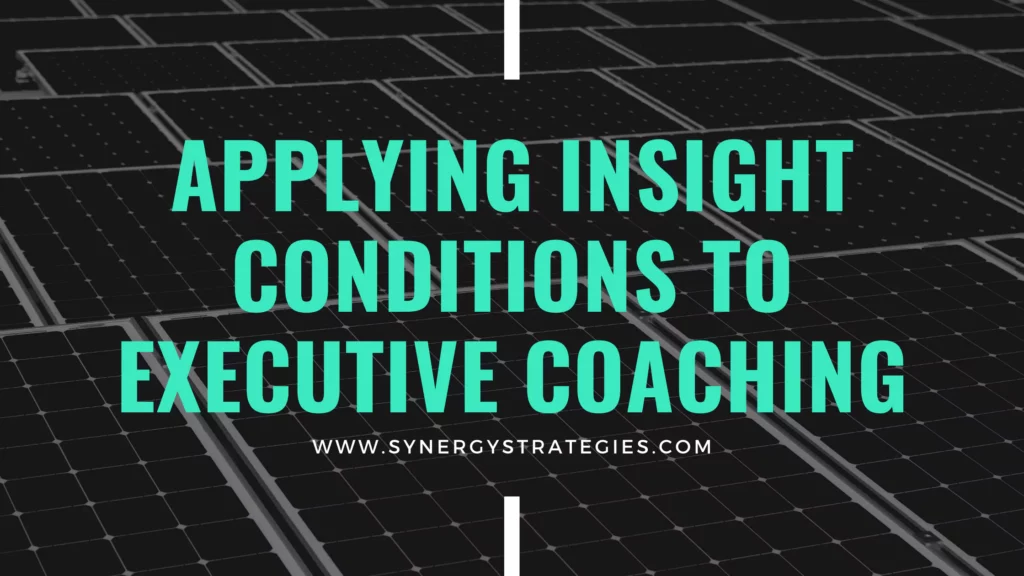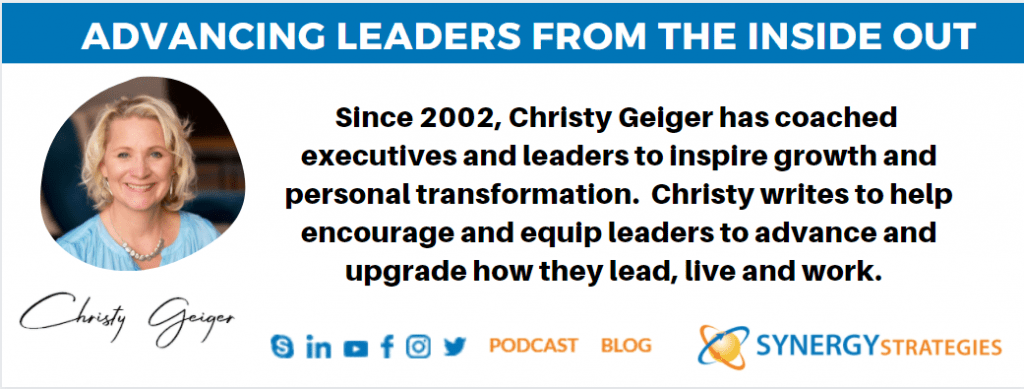Understanding the conditions that cultivate insight thinking could have many applications to Executive Coaching. While some of the “activities” that are recommended to set the stage for more natural insights might not seem “new”, they provide a reason why doing an activity is useful. It also helps leaders and coaches to better design strategic conditions for insight.
One key in coaching is to support leaders to develop skills to better navigate complex challenges. Sometimes it seems like this is about improved Emotional Intelligence, speedy analytical thinking, or quick decision making. However, often leaders continue to be stuck as they vacillate on which direction is best. They see pros and cons, look at the cost, think about the team, and collect a lot of data but still, feel confused.
This overwhelm can happen with many major decisions from setting direction, letting a team member go, determining growth/expansion, handling a crisis, etc. The leader (and even coach) who has mastered foundational and complex analytical problem solving can feel frustrated. There was a time where this approach worked well. It allowed quick movement and productivity. It is easy to return to analytical problem solving and detailed brainstorming to try and find solutions for these more complex, new challenges but there is a struggle as the solutions are not as clear, easy, or obvious.
How can we set the stage for our coaching clients to have more insights in and outside of coaching?
How to create insight conditions:
-
- CREATE POSITIVITY: Setting an environment that is relaxed, happy, and comfortable within the call helps to get in the right frame of mind. In coaching this is about enjoying the client, allowing some humor and fun; this helps relax the brain and put it in the right space for open thinking. In contrast, being “all business” and “right to the point” can almost create a “hard focus” and pressure that can reduce the brain’s ability to access this more creative thinking space. At times in coaching, I have been “all business”, being a high directive profile, plus thinking it was more professional to get right to the point. However, neuroscience shows to create conditions for insight, it is better to allow space for laughter and play, both in the coaching call and in life in general (for the coach and leader).
- FOCUS ON BIG PICTURE PROCESS OVER DETAIL: While it is natural to gravitate to “analytical” problem solving and there can be a time and place for this, doing so can overstimulate the PFC to have a rapid firing of thoughts and solutions. Not only is the art of coaching asking powerful questions, but it is also critical to help the brain access insight. Asking questions that shift leaders to an optimistic, expansive, and solution-focused space opens the door for new insight. What is helping or working and what are they learning? What solutions they have already thought of? Ask questions to expand thinking to reflect on what x and y might have in common. Help to bring them back to how it relates to vision, etc. This “broader” thinking supports moving away from the narrow “hard focus” of the “problem” to a wider lens which can stimulate sudden new thoughts/connections and unexpected solutions.
- GUIDE ABSTRACT THINKING: The use of illustrations, metaphors, similes, and analogies can be powerful to help the brain relax from a hard focus on the problem and consider something that it is like or similar to. Often when thinking about the “situation” in a different context, the illustration can bring greater insight and new clarity new meaning is developed and extracted. Doing this is often memorable as an “illusion”, “story” or “image” summarizes the essence of the challenge.
- RECOGNIZE AMYGDALA EMOTIONAL MEMORY. In addition to the importance of positive energy mentioned above, recognizing when insight is happening is often earmarked by a surge in emotion, positive or negative (although the surge seems more positive when insight is being birthed). Recognizing and allowing the emotion is important as it helps to deepen the connections and lock in the insight. It is not just about “sitting” with the insight, rather “looking around” and absorbing the connections, emotion, significance, and impact of the connection that is being made. The amygdala helps to lock in a memory so that it is not forgotten because it is “emotional” and therefore imprints deeper into the mind; making the insight remembered and therefore more readily applied, referenced, and used.
After the call and as a general rule of thumb for life to process insights:
-
- ENCOURAGE PROCESSING. Taking a step back to reflect and also do mindless activity allows the subconscious mind to work. This means resting the hard processing conscious mind. This could be activities like journaling after a session to just release thoughts. Allowing time to go for a walk or do something more brainless (cleaning up, sorting, assembly, etc.). It could also be a time to do something abstract (drawing, coloring, repair, etc.). It follows setting conditions where additional insights happen (in the shower, driving, etc.) and builds in intentional space for brain rest after a period of discussion and reflection to allow deeper thoughts and connections to surface.
- DEVELOP A DIVERSIFIED TEAM. Some call it their executive round table, winners circle, or power team. This is an intentional effort to engage people who leaders respect and trust but hold a variety of perspectives and opinions. First, these individuals can be a source to share insights. By repeating and sharing the learning deepens and locks in the learning to greater memory. Second, sharing and getting their thoughts is not to please and accommodate all ideas, rather ensure that the leader’s thinking is challenged, broadened with different perspectives, and able to see situations from different angles. This will equip the leader with more data points to be aware of. It is different than over gathering information. Rather, it is a system for expanding awareness and perspective so that when a leader is processing and reflecting they have more diversification to have wider connections to create new thoughts.
- ENSURE BALANCE. Encouraging leaders to plan and balance their time vs. overworking is critical. At times leaders can feel overloaded and when they feel particularly overwhelmed it is common to work harder and longer. The challenge is for the leaders to find the new insight and solution they desperately need, it is important to have downtime. If a leader is working excessive hours, overanalyzing, or over-isolating it sets them up to shut off conditions that provide insights and leaves them only with analytical problem solving which continually falls short of a solution that really provides clarity.
- APPRECIATE THE NATURAL MIND: Humans are not computers. One of the unique gifts of the human mind is the ability to have insight which is an energetic rush of new realizations and connections. While we can error in our thinking, the fact that the brain can understand abstract concepts and challenges beyond data points and facts is what creates a more compelling vision, powerful solutions, and creative innovations. The “human” condition creates a mind that is dynamic, sensing, and emotionally wired which fuels our ability to have new insights, understanding, and ideas.
The study of ways to help humans have more insight conditions is fascinating and useful to support myself and executives to find great solutions to the complex problems that continue to face them as they navigate life and leadership.






